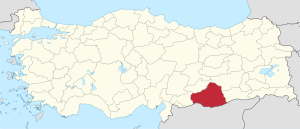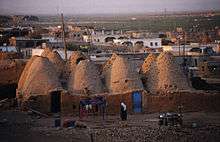Şanlıurfa Province
Şanlıurfa Province (Turkish: Şanlıurfa ili, Kurdish: Parêzgeha Rihayê[2]) or simply Urfa Province is a province in southeastern Turkey. The city of Şanlıurfa is the capital of the province which bears its name. The population is 1,845,667 (2014). The province has a Kurdish majority, with a significant Arab minority.[3]
Şanlıurfa Province Şanlıurfa ili | |
|---|---|
 Location of Şanlıurfa Province in Turkey | |
| Country | Turkey |
| Region | Southeastern Anatolia |
| Subregion | Şanlıurfa |
| Government | |
| • Electoral district | Şanlıurfa |
| • Governor | Abdullah Erin |
| Area | |
| • Total | 18,584 km2 (7,175 sq mi) |
| Population (2018)[1] | |
| • Total | 2,035,809 |
| • Density | 110/km2 (280/sq mi) |
| Area code(s) | 00414 |
| Vehicle registration | 63 |
Districts
Şanlıurfa province is divided into 13 districts (capital district in bold):
Geography
Area 18,584 km² (7,173 sq. miles), the largest province of Southeast Anatolia with:
- Adıyaman to the north;
- Syria to the south;
- Mardin and Diyarbakır to the east;
- Gaziantep to the west;
Şanlıurfa includes several major components of the Southeastern Anatolia Project (in Turkish Güneydogu Anadolu Projesi (GAP)) designed to:
- exploit the hydropower potential of the Tigris and Euphrates Rivers;
- dramatically expand irrigation for agriculture; and
- develop the economy of the region.
This very large-scale, state-sponsored development project involved the damming, redirecting, hydroelectric tapping and other utilization of rivers in this broad, semi-arid region. (The rivers then flow into Syria and Iraq). The GAP includes 22 dams and water supply for 1.8 million hectares for agricultural areas.[4]
Even before GAP, Şanlıurfa Province had the largest share of cultivated and cultivable land in the GAP region, due to its flatness and highly fertile, agricultural land. The Şanlıurfa and Harran Plains extend over an area of about 1,500 km² (579 sq. miles). Irrigating these plains is one of the most important components of GAP.
Politics
On 1 January 1928 the province was included into the First Inspectorate-General over which an Inspector-General ruled according to the policies recommended in Report for Reform in the East.[5] The Inspectorate was governed with martial law and span over the provinces of Hakkâri, Siirt, Van, Mardin, Bitlis, Sanlıurfa, Elaziğ and Diyarbakır.[6] The office of the Inspector General was dissolved in 1952.[6]
Şanlıurfa once being a relatively competitive province between the ruling Justice and Development Party (AKP) and the True Path Party (DYP), it is now one of the most solid AKP provinces.
While the AKP managed to win Şanlıurfa with a comfortable 43.04% during the 2004 local elections, it has since then increased its margins of victory here. Following the diminishing popularity of smaller parties such as the DYP, Şanlıurfa heavily shifted towards the AKP, winning the November 2015 election with 64.55% of the votes. Şanlıurfa once again showed its status as an AKP stronghold in the 2017 referendum, with the Yes vote winning with a wide margin of 41.8%.
The Peoples' Democratic Party (HDP) came in second with 38.1 in the general elections in June 2015[7], and with 28.2% the HDP was also second in the November 2015 general election.[8]
The far-right Nationalist Movement Party (MHP) scored an exceptional 7.18% in the 1999 local elections. Its vote share eventually ebbed to a more usual 2.97% in the 2004 local elections. The MHP showed a significant recovery in the indecisive June 2015 election by winning 5.56% of the votes. However, the MHP went on to suffer from a nationwide loss in the upset November 2015 election, with its vote share declining to 2.75% in Şanlıurfa.
The centre-left Republican People's Party (CHP) usually maintains a modest share of slightly below 5%. Similar to the other two opposition parties, the CHP suffered a loss in Şanlıurfa, going from 4.10% in the June 2015 election to 2.70% in the November 2015 election.
The current Governor of Sanliurfa is Abdullah Erin.[9]
Places of interest
The province is famous for its Abrahamic sites such as Balıklıgöl, where Prophet Abraham was cast by Nimrod into fire that is believed to have turned to water. Also the Mevlid-i Halil Mosque, where Abraham is believed to be born in the cave next to the mosque is well known.[10] Within the province, approximately 12 km (7 mi) northeast of the city of Şanlıurfa, is the pre-historic site of Göbekli Tepe, where continuing excavations have unearthed 12,000-year-old sanctuaries dating from the early Neolithic period, considered to be the oldest temples in the world, predating Stonehenge by 6,000 years.
The following tombs and sacred spots are located within the province:[11]
- Prophet Ibrahim (Abraham)'s birthplace
- Prophet Ayyub (Job)'s cave and tomb
- Prophet Alyasa (Elisha)'s Tomb
- Imam Bakir's Tomb
- Shaykh Hayat al-Harrani's Tomb
- The first burial place of Said Nursi
- Rahma Hatun's Tomb
- Neolithic Temple at Göbekli Tepe
- Neolithic Settlement at Nevalı Çori
Gallery

Balıklı Göl and Ridwaniya Mosque 
Balıklı Göl (Fish Pond) and people 
Mevlid-i Halil (Birth of Abraham) Mosque 
Salahaddin Mosque 
Urfa's central market 
Traditional Narrow Streets 
Urfa's retailers 
Harran District
References
- "Population of provinces by years - 2000-2018". Turkish Statistical Institute. Retrieved 9 March 2019.
- "Li Rihayê 15 roj qedexe hat ragihandin" (in Kurdish). Rûdaw. 8 October 2019. Retrieved 27 April 2020.
- Mehmet Gürses (2018). Anatomy of a Civil War: Sociopolitical Impacts of the Kurdish Conflict in Turkey. University of Michigan Press. p. 11. ISBN 9780472131006.
- "GAP Regional Development Administration". gap.gov.tr. Retrieved 2020-03-31.
- Üngör, Umut. "Young Turk social engineering : mass violence and the nation state in eastern Turkey, 1913- 1950" (PDF). University of Amsterdam. p. 258. Retrieved 8 April 2020.
- Jongerden, Joost (2007-01-01). The Settlement Issue in Turkey and the Kurds: An Analysis of Spatical Policies, Modernity and War. BRILL. p. 53. ISBN 978-90-04-15557-2.CS1 maint: date and year (link)
- "Şanlıurfa Haziran 2015 Genel Seçimi Sonuçları". Yeni Safak. Retrieved 27 March 2020.
- Şafak, Yeni (2020-03-28). "Şanlıurfa Seçim Sonuçları 2015 - Genel Seçim Kasım 2015". Yeni Şafak (in Turkish). Retrieved 2020-03-27.
- "Şanlıurfa Valiliği". www.sanliurfa.gov.tr. Retrieved 2020-03-27.
- Delanghe, Cyriane (2018-08-20). Harper & Hicks: 2 - Les larmes de Zénobie (in French). p. 18. ISBN 978-2-36475-431-7.CS1 maint: date and year (link)
- TÜRBELER
